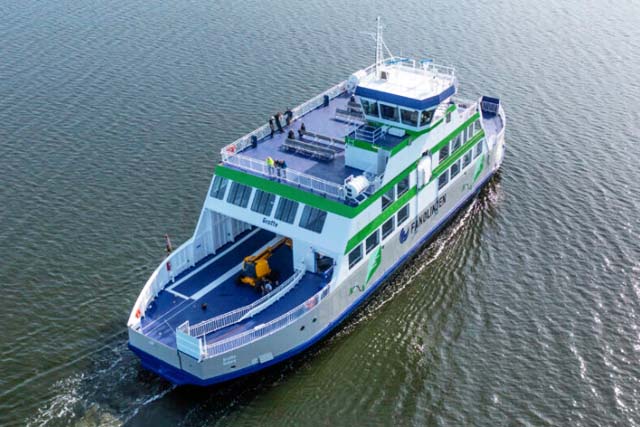According to Danish naval architecture consultancy OSK-ShipTech, in the CO2 emissions debate, the shipping industry should steer a different course from that which focuses only on CO2 emissions from fuel, and concentrate on the broader picture.
Although the ferry industry has led the way when it comes to implementing alternative fuels and a transition to battery propulsion. It is generally understood that the smaller the ‘direct’ emissions footprint from ship propulsion, the bigger the ‘indirect’ emissions footprint from the construction of the ship.
Anders Ørgård, CCO OSK-ShipTech, said: “Reducing the direct CO2 emissions should remain a priority, but shipowners cannot turn a blind eye on the indirect contributors of CO2 emissions: notably the manufacturing process of a ship and all the components it is made of.”
A recent study conducted by the consultancy revealed that for a full-electric ferry, powered by climate-friendly electricity, non-operation-related CO2 emissions could reach well in the excess of 55% of the total CO2 emissions produced during the ship’s 20-year life cycle. This study provides food for thought for responsible shipowners and illustrates that a holistic life cycle approach is paramount when considering a newbuild.
Ørgård said: “Rather than exclusively focusing on the emissions from operations, shipowners should make a cradle-to-grave life cycle analysis. A life cycle analysis offers the opportunity to develop a build strategy, reducing the emissions during both construction and operation, thus further optimising the ship’s operational life.”
The study comes on the back of a controversy surrounding the idea of sustainability and the new guidelines from the Danish consumer ombudsman, which emphasise that statements like ‘emission-free’ and ‘climate-neutral’ are to be fully documented through the product’s entire life cycle by use of life cycle analyses and verified by experts. In the case of ships, such a life cycle analysis includes a cradle-to-grave evaluation. In addition to the ship’s operation, the CO2 footprint from construction and recycling of the ship should equally be considered.
OSK-ShipTech’s study included a life cycle assessment of Fanølinjen’s 2021-built, full-electric ferry Grotte; a 50m long double-ended ro-pax vessel operating the 12-minute Esbjerg-Nordby shuttle service. Notwithstanding the short distance it covers, Grotte effectively sails 12 hours per day. The study is therefore representative of a large ro-pax ferry with an equivalent daily operating time of at least 12 hours. The assessment, which covered the six stages in a ship’s life, all the way from mining of the resources and processing of the steel to the recycling of the ship, was executed in line with ISO 14040 and ISO 14044 standards.
For redundancy’s sake, and to make long positioning trips possible, most electric ferries are still equipped with diesel engines. Experience from operating full-electric ferries has taught that they operate for about 90%-95% of the time on electricity. For this reason, they also need backup power from other energy sources. As per publicly available data, the climate-friendly electricity used to power Grotte has an emissions intensity of 0.0187kg CO2/kWh, compared to the 0.297kg CO2/kWh of the electricity generated from a typical mix of renewable and conventional energy sources (such as coal, wood chips, and natural gas) available on the grid. OSK-ShipTech has calculated that during its entire lifespan, from cradle to grave, Grotte will produce 2,508t CO2-eq from the ship’s operation with 1,833t CO2-eq attributable to the manufacturing of the vessel. As the ship and its materials will be recycled upon demolition, scrapping of the vessel will have a positive CO2-eq footprint of 1,124.54t.
Ørgård added: “Our analysis clearly illustrates that a zero-emission ship doesn’t exist at all. To put it simply, one can no longer ignore the CO2 emissions generated from manufacturing, which can be more than 50% of the cradle-to-grave CO2 footprint in some cases.”
Following this in-depth life cycle assessment, OSK-ShipTech is ready to apply the knowledge gained in future newbuilding projects, helping shipowners to develop a build strategy to drastically reduce CO2 emissions during the construction processes.
Ørgård concluded: “A life cycle analysis already starts in the ship’s concept stage, thus allowing us to develop a build strategy, which we can take into account, when we calculate the total cost of ownership and the total cradle-to-grave CO2 burden. One should also consider the country of build. In many countries, steel production is coal-fired. As part of their build strategy, shipowners should equally consider where to build their ships and where to purchase the steel. Our interior design branch, Steen Friis Design, has developed a tool to calculate the CO2 emissions from the accommodation. This is yet another example demonstrating that we are with the shipowner all the way.”



